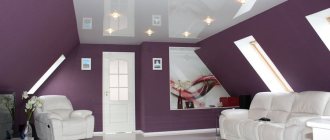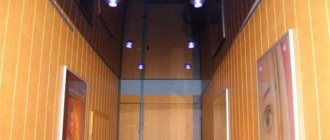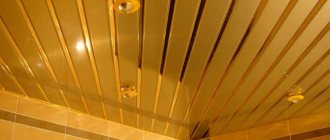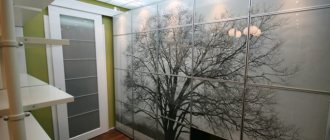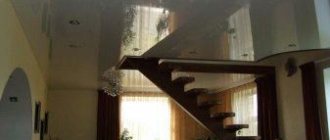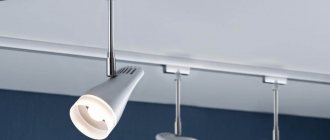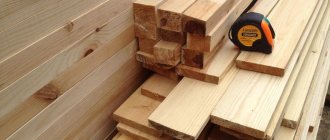Installation of suspended ceilings does not require specific skills or special devices; only components for suspended ceilings are needed. This work is relatively simple. And it takes relatively little time to install. The most important thing is the preparatory stage:
- read the instructions for installing suspended ceilings;
- decide on the installation method;
- prepare components for suspended ceilings.
Installation of suspended ceilings
When installing a stretch ceiling, the main structural element is a tightly stretched canvas. It is attached using a baguette - a guide profile. Stretch ceilings can be single-level or multi-level, single-color or two-color. Installation of ceiling structures is carried out using profiles having different configurations.
Note. Lighting fixtures are attached to the tension fabric using a special technology. To bypass pipes (water, heating, gas), special plates with rings are used.
Schematic diagram of suspended ceilings
This type of finishing is a suspended structure consisting of a metal frame and a polymer fabric. Special profiles attached to the walls are used as a frame. PVC film and fabric impregnated with special compounds are used as tension fabric.
The canvas is stretched over the frame, resulting in a smooth, defect-free ceiling of different shades and textures. Installation can be carried out in different ways - hot and cold. The frame for different materials is also different.
The technology for installing suspended ceilings using PVC film involves the use of heat guns, with the help of which a temperature of +50+60 degrees is created in the room. Under its influence, the vinyl film increases in size, and after installation, cooling, it acquires its previous dimensions. The result is a tightly stretched panel.
This method was used in ancient times, when cloth moistened with a special solution was stretched under the ceiling. The dried material created the appearance of a smooth ceiling with different colors and textures, which depended on the fabrics used.
Installation of suspended ceilings is carried out using several methods:
- harpoon
- glazing bead
- clip-on
- wedge
Harpoon method
This method is used to install suspended ceilings made of PVC film. In this case, the panel is cut out 5-7% less than the area of the main ceiling. After this, special thickenings called harpoons are welded along the perimeter of the cut fabric (and previously welded, if necessary, on special machines). This is where the name of the installation method comes from.
Harpoons are inserted into special profiles pre-installed on the walls, pulling the heated fabric. Due to the fact that the panel is smaller than the ceiling area, the cooled material is stretched so tightly that it resembles a drum. This results in a completely flat and smooth surface.
Important! When installing a stretch ceiling in large rooms where the area exceeds 20 square meters, slight sagging of the film coating is possible. In this case, an intermediate fastening of the coating to the ceiling profile is made.
You cannot make mistakes in size when cutting out the panel. The maximum deviation from the dimensions can reach no more than 1 cm.
The advantages of a stretch ceiling installed using the harpoon method include the fact that the panel can be easily dismantled if necessary, for example, for repair work. And then it can be installed again in the same or another room.
Bead method
Bead fastening of suspended ceilings
Stretch ceilings, the installation technology of which is carried out in this way, imply the use of special profiles. They are sometimes called baguettes, and the folded edge of the panel is inserted into them. This operation is carried out with a wooden or plastic spatula, after which the installation hole is closed with a polymer or wood bead.
In this case, the panel is cut out larger than the area of the base ceiling by 15-20 cm on all sides. This method is also called the cam method. Its disadvantage is that it can only be used in rooms with regular geometric shapes. That is, the glazing bead method is not suitable where there are rounded walls or protruding elements. Plus, such a suspended ceiling cannot be dismantled and reinstalled.
Wedge method
This type of installation is not much different from glazing bead. The only difference is that instead of glazing beads, they use unique wedges. The advantage of the method is the possibility of its use for installing ceilings of any configuration.
Here, just as with the harpoon method, dismantling is possible, but not the entire panel, but only a small part of it.
Clip method
Clip fasteners are used to install fabric ceilings
Fastening a stretch ceiling using this method is also called “clothes-pin fastener”. It is used to install only fabric (seamless) ceilings.
This is due to the increased strength of the fabric, as a result of which the clips installed on the edge of the fabric do not tear it under the influence of tensile loads. For the installation of such materials, special profiles are used, which are structurally different from all others. They do not require the installation of a decorative strip covering the mounting slot in the baguettes with harpoon or wedge installation methods.
The advantages of this method are the absence of heating the room to high temperatures, which are not entirely beneficial for the environment, house plants and wall decoration.
Methods for attaching tension fabric
Installation of suspended ceilings can be done using several methods. The choice of installation method depends on the properties of the tension fabric used, because PVC film and textile fabric are attached differently. The most common fastening methods are:
- harpoon – used for mounting PVC film;
- clip - used for mounting fabric panels;
- glazing bead (wedge) - used both when installing fabric panels and when installing low-density panels made from PVC film.
Harpoon method
The harpoon fastening system involves the use of a flexible plastic latch (harpoon), which is factory-fused to the canvas. In this case, the size of the canvas must be strictly maintained. Guides are attached to the ceiling or walls during installation. The prepared canvas is heated to t=55-65C. Then the harpoon is inserted into the groove located in the guide profile until a characteristic locking click occurs. The place where the canvas is attached is hidden with a decorative overlay. The harpoon system allows, if necessary, to dismantle the canvas and then install it.
Harpoon fastening of a stretch ceiling
Clip method
Fabric sheets are attached using the clip method. PVC baguettes and a clip with an elastic clamp are used. This fastening system requires cutting the fabric with a small margin. During the installation process, the edges of the canvas are carefully tucked inside the baguette and secured with a clip. In this case, the tension of the canvas can be adjusted by bending the clip with a staple. Secondary installation of the fabric sheet is not provided, because When the fabric is stretched, its excess part (reserve) is cut off.
Fastening a stretch ceiling with a clip
Bead method
The bead (wedge) method is used much less frequently, since, according to experts, it is not capable of ensuring reliable fastening of the web. With this fastening method, the canvas is inserted into a U-shaped baguette and clamped with a glazing bead. The joint is closed with a decorative plug installed from below. When using the glazing bead method, the fabric is weakly stretched. This method is not suitable for heavy canvases and large rooms. Dismantling this system requires a lot of experience, because... the canvas may be damaged.
Note. When selecting component materials, it should be borne in mind that for each of the given methods of fastening the canvas, different guides are used
Overview of various methods of installing suspended ceilings
Stretch ceilings have long been an integral part of modern construction. They are a structure based on a thin but very durable fabric, which is stretched over a frame prepared in a special way. In accordance with the shape and design of the frame, the features of the finished ceiling, the specific number of levels, and the distance from the base base are determined. The reliability, strength and service life of the product are largely determined by the specific method of fastening.
General rules and requirements
Installation methods are determined by the type of fastening used. Fastening systems are based on the use of aluminum profiles or polyvinyl chloride baguettes. They are used to create a frame, which is then fixed to the base ceiling or walls. Depending on this, there are methods for installing suspended ceilings based on profiles or baguettes.
Frame fastening systems for tensile structures include the use of special dowels and high-strength self-tapping screws. When choosing any type of fastening, a mandatory point is to ensure the strength of the finished structure and its resistance to long-term stress, which is created by the stretched ceiling fabric. Therefore, the frame must be attached to a reliable foundation based on concrete, metal or brick. Depending on this, the surface used for fastening is selected. This becomes either the walls or the base surface of the ceiling.
If it is necessary to secure the frame to a plasterboard surface, dowels specially designed for this purpose are used, which increase the strength characteristics of the structure. They are made in the shape of a butterfly.
In the case of wooden walls, suspended ceilings can only be installed if an additional element of rigidity is provided, installed around the entire perimeter of the base ceiling. If this requirement is ignored, the integrity of the wooden structure may be damaged under the influence of the tension created by the tensioned fabric.
Types of installation of tensile structures
Currently, four main types of web fastening are used:
- harpoon;
- wedge;
- glazing bead;
- “clipso”.
They all have their pros and cons. The choice of specific equipment is determined by the shape of the ceiling surface, the financial capabilities of the customer, and some other factors.
Harpoon method
This method is one of the most expensive and at the same time simple and reliable methods of fastening tension structures. When implementing it, it is necessary to absolutely accurately calculate the parameters of the ceiling fabric. To carry out calculations and subsequent cutting, a specially developed computer program is used. When manufacturing the canvas, deviations of only a few millimeters are allowed. On-site adjustments are not permitted.
The method consists of performing the following actions:
- along the entire perimeter of the polyvinyl chloride film, an edging is made based on a solid material (in appearance it resembles a hook);
- using the edging, the canvas is secured to the profile;
- the use of harpoon technology during installation makes it possible to significantly reduce it due to the fact that the film is stretched during fastening.
Before stretching the fabric, it must be heated and inserted into the profile grooves for fastening.
The film is stretched first diagonally, then along the entire perimeter. After cooling the film, the canvas is finally stretched and an ideal, evenly stretched, smooth and even surface is obtained.
- When using this method of installing tensile structures, there is no need to attach skirting boards to the walls - this is perhaps one of the main advantages of harpoon technology.
- Installation of suspended ceilings using this system is much faster than installation of suspended ceilings with a glazing bead or wedge system.
- Harpoon ceilings can be dismantled and reinstalled, which is extremely important for unexpected repairs or in the event of a leak from the upper floor.
Bead fastening method
This is perhaps the most accessible of all fastening methods. To install the ceiling in accordance with the glazing bead system, the PVC sheet must be made larger than the main ceiling.
The profiles are fastened to the walls, very close to the ceiling. The canvas is mounted to the profiles.
The distance between the suspended and main ceilings is 1.5 cm. The film is attached to the profile using a plinth. It can be made from foam or plastic. When using this mounting method, you can easily gain access to the main ceiling if it is necessary to eliminate the consequences of flooding or replace wiring.
With the bead method of fixation, the main structural elements are:
- glazing bead based on wood or plastic;
- special aluminum baguette;
- inserts;
- directly to the canvas.
Glazing beads are used to attach the canvas to the baguette.
The main advantage of this method is that there is no need to take precise measurements of the room, since the installation of the canvas is carried out with a 15-20-centimeter margin around the entire perimeter. The cost of such work is quite low.
The main disadvantage of this method is that it is not repairable if the surface is damaged.
Wedge method
This option is an ideal choice for connoisseurs of high quality at a decent price.
First, a fastening profile is installed along the entire perimeter with a distance of 3 cm from the main ceiling, after which the edges are clamped in the profile using special cone-shaped elements - wedges. When the canvas begins to cool, it is tensioned, resulting in a very smooth surface. Excess parts of the canvas are simply cut off or hidden behind the baseboards.
The main advantages of the method:
- when using the wedge method, there is no need to carry out preliminary calculations: knowledge of the geometry of space is sufficient;
- such systems can be customized on site, which makes their use very convenient when working in rooms with decorative elements of a space of complex configuration;
- This method is considered the cheapest, which often becomes the determining factor when choosing it.
Among the disadvantages of the wedge system it should be noted:
- manual method of tensioning the canvas, which in the future often leads to its sagging;
- inability to dismantle the structure and reinstall it (for example, in case of leakage)
Clipso fastening system
The second name of the method is “clothespin”. It is specially designed for ceilings made of Clipso or Descor fabrics. The method combined the features of harpoon and wedge fastening systems. The installation process is significantly simplified due to the use of a special “clothespin” latch in the profile itself and as a result of the strength characteristics of the fabric-based fabric. All this allows you to create flawless ceilings.
All you need to use this method is a canvas and a baguette. The canvas is inserted into the baguette using a spatula. Fixation is carried out using cams pre-made in the baguette. Since there should be no gaps in it, the use of plinth is impractical. The fabric is tensioned without preheating.
This method significantly reduces installation time and is suitable for homeowners who are categorically against heating the interior, as well as in cases where, for certain reasons, heating is impossible. In these cases, gasless installation of ceilings is carried out, making it possible to install ceilings in places where this was previously impossible.
The Clipso method is one of the most expensive.
Accessories for suspended ceilings
The correct selection of components affects the appearance of the tension fabric and its reliability.
Ceiling molding Separating molding Wall molding Baguette for curved areas
show all
Platform for the lamp Thermal ring Decorative insert T-shaped Decorative insert corner
To install the tension fabric you will need:
- guide profile (baguette);
- fastening material;
- rings and platforms for mounting lamps;
- inserts for pipe bypass;
- special tool.
In order for the components to be correctly selected, you first need to know exactly the size of the room, decide how many levels there will be, where the transitions are located, what type of fabric will be chosen, how many and where the lamps will be located. All this should be shown on the plan.
Sketch of a two-level stretch ceiling
According to this plan, the canvas is ordered. Particular dimensional accuracy is necessary for PVC film - film, because... It will not be possible to change the size once the harpoon has been fused.
Note. When determining the size of the PVC sheet, it is necessary to take into account the size of the guides. When ordering canvas, you should know exactly both the size of the room and the shape of the baguette used. Even a minor error in calculations can change the appearance of the ceiling.
Frame structure for a stretch ceiling
The basis for any type of ceiling covering, regardless of the method of its installation, is the frame, which bears the main load. The appearance of the finishing coating, its durability and performance properties will depend on how correctly and firmly the wall or ceiling profiles are installed.
Nowadays, you can make a suspended ceiling with your own hands, if you know the technology and have all the necessary tools and devices. There are a lot of materials on the Internet from which anyone interested can learn how suspended ceilings are installed.
For the frame, profiles made of aluminum or plastic are used. There are:
- Corner profile - for installation in the corners of the room, when installing a multi-level ceiling, when there are various protruding elements in the room such as beams, columns, etc.
- The profile, marked with the letter “H,” is used in creating curved frame structures and can have cuts on the back side for better bending in the desired direction.
- A structural profile that allows you to build a frame for a suspended ceiling at different levels - curved or other geometric shapes.
In addition, manufacturers offer profiles RV/RN No. 8 and No. 16, with which you can make rounded frame elements with a radius from 7 cm to 5 meters and with a bend on the inside or outside. Ceiling consoles are used to secure them.
Marking installation locations for profiles
Marking and installation of profiles
As with any suspended ceiling, the first thing to do is determine the horizontal level of the places where the wall moldings will be installed. For ceiling elements this operation is not necessary. The horizontal level is determined by measuring each corner and determining the minimum height of the room using a building, water or laser level.
The installation location of wall profiles relative to the base base is also determined by the type and size of lighting fixtures that are built directly into the stretch ceiling structure.
Before work on the construction of such a structure begins, all construction work must be completed in the room. An exception is when applying wallpaper, since hot air can negatively affect its appearance.
Profile installation
You can install baguettes using self-tapping screws or dowel-nails, which depends on the material of the walls and ceiling.
Important! Experts advise using plastic baguettes, which do not have to be decorated with special slats or tapes, since in the future they will look like ordinary ceiling plinths.
After marking, proceed to installing the profile
To install the frame, baguettes are cut into the required lengths and attached to the wall or floor slab in increments of no more than 10-15 cm. You should know that in the corners it is necessary to install solid profiles, bending them to the size of the corner. This ensures better reliability of the stretch ceiling.
The process of installing profiles should be carried out taking into account the electrical wires passing under the ceiling. Therefore, you should first find out where the electrical distribution boxes are located and how the electrical wiring is laid. This should be done for your own safety. After all, by breaking through an electrical wire, a person exposes himself to mortal danger.
If you need to join profile sections, do it overlapping. And the fastening itself is carried out at a distance of at least 2 cm from the end.
Accessories for suspended ceilings: platforms and rings for lamps
Special platforms are used to mount lighting fixtures. The material for them is heat-resistant plastic. The shape of the platform is round, square, or cross-shaped.
Platforms for future lighting fixtures are attached to the base surface in pre-marked places. On the front side of the canvas, thermal rings are glued under the lamps, which serve as a heat sink. Inside each thermal ring, a hole is cut in the canvas into which the lamp is attached and connected.
Thermal ring
Attaching the lamp to a suspended ceiling
Installation of electric lighting devices in a suspended ceiling
Due to the fact that mounting rings for suspended ceilings (thermal rings) and platforms are available in a variety of sizes, they can be matched to various lamps. Universal platforms, which consist of rings of different diameters, allow you to select the required diameter by removing unnecessary ones with a mounting knife.
To hang the chandelier, you must use the hook included with the platforms. First, a hook is attached to the ceiling, a platform is installed, and then the fabric is stretched. The chandelier must be hung on a hook, secured to the platform, and all cracks must be pressed with a decorative glass.
Scheme for installing a chandelier on a suspended ceiling
Pipe fittings
If there are pipes in the room, the question invariably arises: “How to bypass the pipe when installing a stretch ceiling?” For a more accurate installation of the tension fabric, bends are used - plates of the required diameter with a cut. The diameter of the plate should be slightly larger than the diameter of the pipe. Before stretching the canvas, the ring should be glued to the canvas from the inside and a hole should be cut inside it. The pipe is inserted into the ring.
Pipe lines
To make the appearance more attractive, sometimes such a plate is installed on the canvas from the outside.
Bypassing pipes, columns and supports
How to dismantle a suspended ceiling with your own hands
Dismantling the finishing material in question may be necessary if the wiring is faulty (remember - we fixed it to the ceiling?) or if liquid accumulates between the material and the ceiling (for example, the neighbors above them flooded it). In any case, the dismantling process can be done with your own hands, without inviting specialists. Step-by-step instruction :
- getting rid of decorative ceiling plinth;
- use a heat gun or a hair dryer to warm up the film;
- carefully pull out the harpoons from the profiles (they directly “press”/fix the canvas) in the corners of the covering;
- We do the same thing around the entire perimeter - remove the harpoons.
During the process of dismantling a PVC stretch ceiling, you will need to constantly warm up the film - this will prevent loss of elasticity and damage to the material.
If you have to carry out the described process with a suspended fabric ceiling, then there is no need to use a heat gun, but certain difficulties may arise when pulling out the fabric tucked into the profile - such material “adheses” tightly to the bead or clip.
After dismantling and fixing the problem, you will have to repeat the procedure for installing the suspended ceiling with your own hands.
The finishing material in question for the ceiling surface is perhaps the most reliable to date. If you operate it correctly and periodically carry out “hygienic procedures” on it, then for a long time you will not need either repair or replacement.
( 84 votes, average: 4.68 out of 5)
Interior decoration of the bath
DIY floor screed
